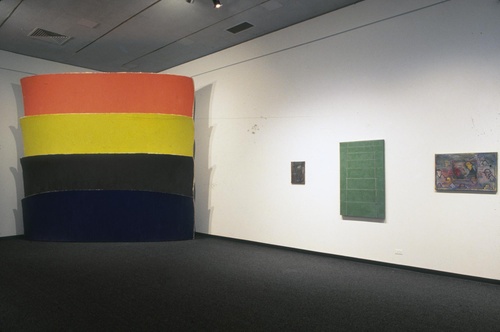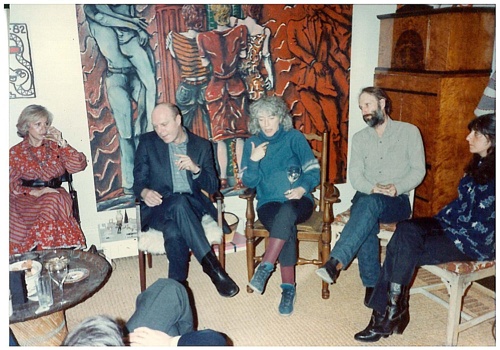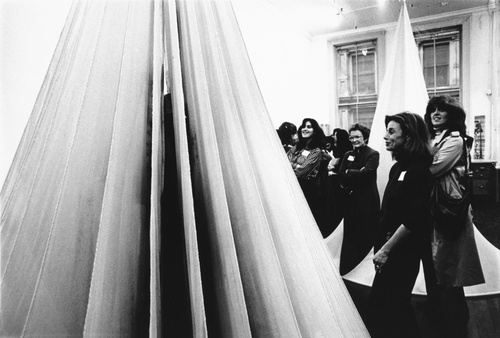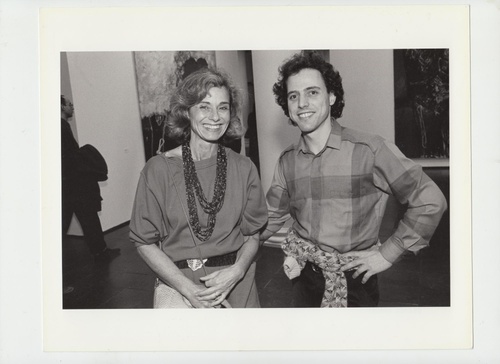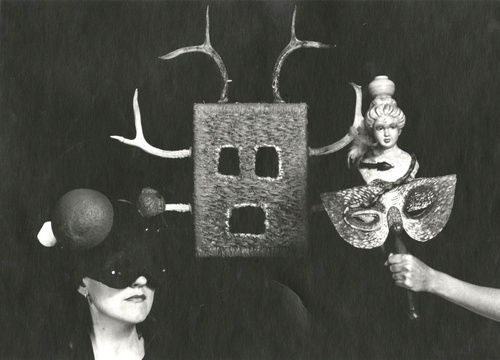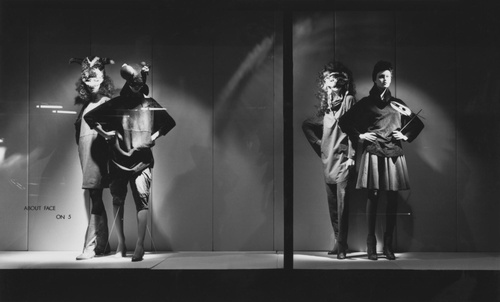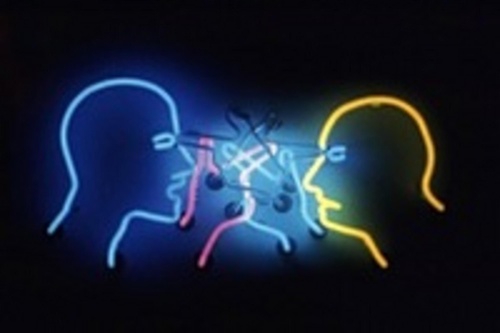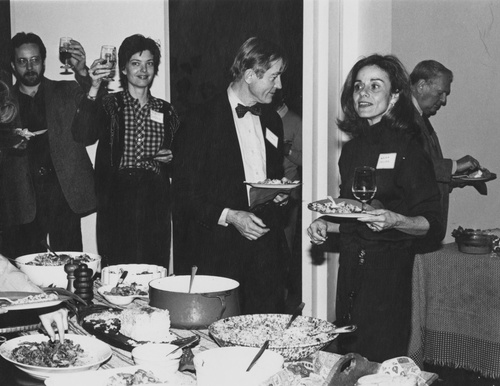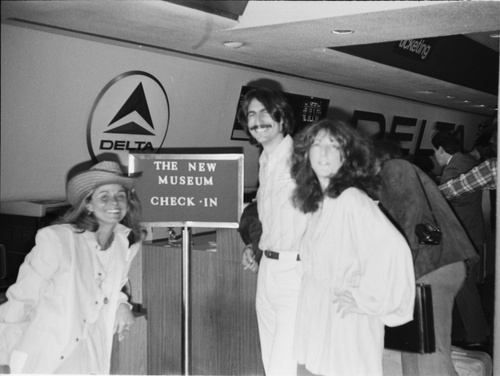Oral History: Laura Skoler
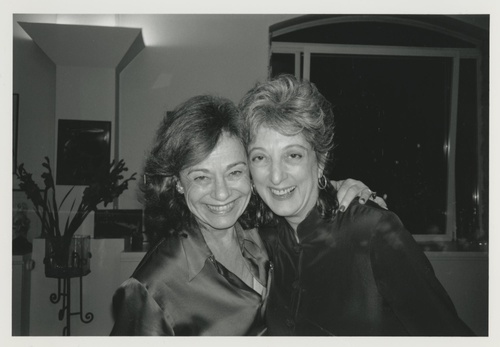
Trustee Laura Skoler and New Museum Founding Director Marcia Tucker
NEW MUSEUM ORAL HISTORY INITIATIVE
LAURA SKOLER, NEW MUSEUM TRUSTEE 1983–PRESENT
INTERVIEWEE: Laura Skoler, New Museum Trustee, 1983–Present
INTERVIEWER: Lauren Cornell, New Museum Curator & Associate Director, Technology Initiatives, 2005–17
LOCATION:May 16, 2017, Laura Skoler residence, New York City
This interview has been condensed and lightly edited from the verbatim transcript. Readers are asked to bear in mind that they are reading a transcript of the spoken word, rather than written prose.
Full transcripts are available from the New Museum Archives by request.
Lauren Cornell: So, Laura, let’s talk about what initially drew you to the New Museum. And how did you become involved?
Laura Skoler: I won’t give you the whole backstory, because we don’t have time. I was introduced to several galleries when SoHo was the gallery deal. And I went to Holly Solomon’s gallery and Holly happened to introduce me to Allan Schwartzman [one of the New Museum’s first curators] and another curator. Holly said, “You must go to the New Museum!”
So I went, and it was an exhibition with, I believe, Elizabeth Murray and maybe Joel Shapiro [“Early Work by Five Contemporary Artists,” 1977]. The Museum was tiny; a one-room gallery and then a very small office space.
Marcia Tucker was not there that day. I inquired, and then I said, “I’d like to volunteer.” A couple of weeks went by, and then Marcia came and we made a lunch date. And she asked, ‘Well, what will you do?’
And I said, “Anything, because I want to learn about contemporary art.” That was it. That was in, I believe, 1977, or ’78, because I remember that I was training for the New York City Marathon while I was there.
LC: Let’s talk about the art landscape at the time. When you were looking around, how was the New Museum different from what else was out there?
LS: That’s an interesting question. I really didn’t know a lot about the other museums. I knew the Met. I knew MoMA. To me, MoMA was–and still is–an institution. But, of course, I loved some of the art.
But with Marcia, it was totally cutting edge. I mean, you felt it. You saw it. And the greatest part was, you got to meet the artists. That’s what intrigued me. And it was a living art.
LC: Yes. So let’s talk a little bit about the artists and Marcia. And, later on, Lisa Phillips [New Museum Toby Devan Lewis Director, 1999-present]. As long as you’ve been involved, the New Museum has always taken risks and shown challenging art.
LS: Yes.
LC: What’s that been like for you as a trustee? To be involved with an organization that takes risks?
LS: I think it’s certainly helped me mature and take risks myself and to approach challenges as opportunities and not as something that I can’t do. I also found it easier to be—how do you say this? To be able to express my own opinion, even if it differed with somebody else’s.
LS: I think it’s certainly helped me mature and take risks myself and to approach challenges as opportunities and not as something that I can’t do. I also found it easier to be—how do you say this? To be able to express my own opinion, even if it differed with somebody else’s.
That was not an easy thing for me, growing up in conservative Boston—to learn how to express opinion. And Marcia taught me.
I went to artists’ studios with her and one of her rules was that you never tell an artist, even if you tell him his work is great and innovative, that their work reminds you of somebody else’s. That was a great lesson that never would have occurred to me.
LC: Why do you think that’s a great lesson? Can you expand on that?
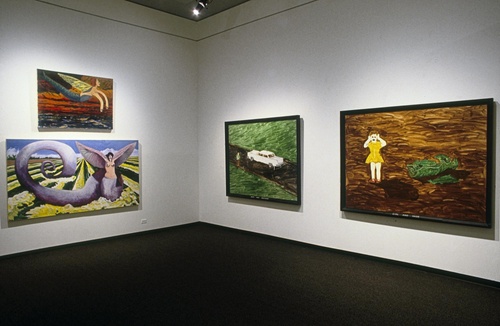
.
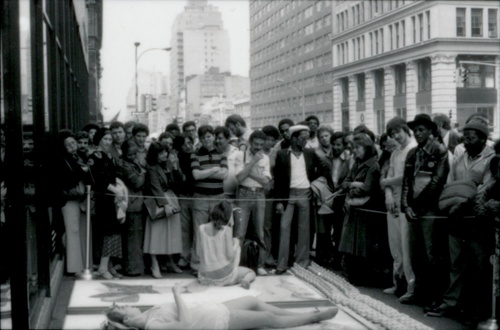
Throughout the New Museum’s history risk-taking took many forms. Early exhibitions such as “’Bad’ Painting,” 1978, (above) challenged conventional notions of style and taste. Photo: New Museum. In other exhibitions, such as Gina Wendkos’ 1981 window exhibition (below), emerging artists activated their works by engaging directly with the public. Photo: Bonnie Johnson
LS: Because each person wants to be unique! And the artist especially wants to feel he or she has created something different.
And I felt that it was very interesting; that I was always challenged by new work. I learned how to think to myself, “Yes, I don’t like this work. It’s okay.”
But I never felt that Marcia was really challenged. I think she had such a big eye that it never felt, to me, like she was challenged. But she was certainly a woman that could ask a lot of questions. And she was a woman very devoted to artists.
LC: So, you’re talking about how the museum helped you take risks and helped you define your voice. And we’re speaking abstractly, in large terms. Are there any projects in particular—artist exhibitions, studio visits—that stand out to you as particularly formative? I know it’s really hard, because there’s been so many.
LS: Yes, too many to recall.
LC: Let me narrow it down a little bit. Anything from the really early years? Anything from really recent times?
LS: Oh, that’s narrow? It’s interesting—I don’t know why it sticks in my mind, but certainly the Leon Golub/Nancy Spero team was a very fascinating couple, besides their individual personalities and their art. And, you know, it’s a learning experience. What others? Well, of course Al Jensen. That was a Marcia introduction. I got to know him and his wife, and I even cooked dinner for them in their home, which was very interesting. So that, from the early days, kind of stands out. From my latter days? My middle days? Louise Bourgeois.
LC: Why is that?

Artist Leon Golub (right-back) and adjunct curator Brian Wallis during an Art Quest panel discussion at Nancy Spero and Leon Golub’s residence in December, 1986. Photo: New Museum
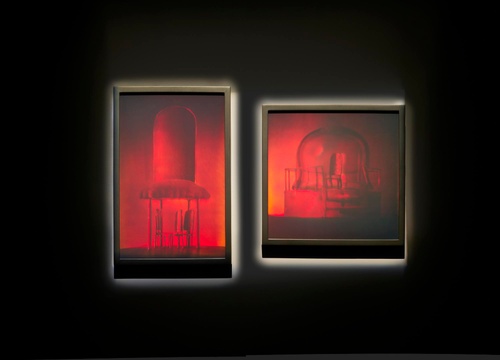
Louise Bourgeois, Untitled #1, 1998 (left) and Untitled #2, 1998. Installation view: “Pictures from the Moon: Artists’ Holograms 1969–2008,” New Museum, New York, 2012. Photo: Benoit Pailley
LS: Just a woman who was unbelievably strong, creative, and defiant. And I always thought of her—I first saw her at Robert Miller’s gallery, when it was somewhere else, and she just wasn’t recognized. It took her a long time, as it does most women. But I think we’re changing.
And contemporary—you’re thinking about contemporary people? I don’t know. I like some younger artists. I mean, I’m looking backwards. Forwards–backwards. I’ve been looking at younger artists taking risks. I really have always bought what I love. Which is the good news, because I live with my art.
So, I’ve had a lot of fun with some younger, newer, and also some older “newer” artists. Like Brenda Goodman, who is an older artist. But I like her work, and I purchased a small piece of hers. So, that’s where I’m going.
LC: So, put another way, the museum’s mission of supporting the new is something that’s really influenced your own personal approach to art and your collection, right?
LS: Definitely. Yeah.
LC: For the record, since we’re not video-taping, Laura Skoler has art covering every square inch of her apartment’s walls.
LS: That’s true. And you want to know something funny? Every gallerist will tell me, “Oh, this is so small; I can find a space.” And when they come up here, they sort of gasp. But I love it! It’s what I like.
LC: Let’s get back to your involvement with the board, because I want to focus on your specific contributions and the memorable projects that you were involved in as a trustee. 1 So were there particular committees or projects that, as a trustee, were important to you?
LS: Well, I actually ran not their first benefit, but their second benefit.2 And I did those events for many, many years. My experience, actually, businesswise, was doing big events.
LC: So, can you tell me a little bit about that? And what was it like, the first one?
LS: The first one that I did? The first one that Marcia did was at the New School, and I just remember that it was nothing really spectacularly special. Then I had this idea, which I suggested to Marcia, to do an edition. Nobody was doing editions—but I knew Marcia knew so many artists— so, I said, “Why don’t you ask an artist to do something, and then we will sell it, and that price will include the benefit tickets—“
LC: It was an influential idea.
LS: Then later we did all sculptural editions. That was sort of how it happened, and very successfully, as you know. We still do limited editions, but now we’ve added additional ones for the benefit—benefit editions, et cetera. I will say that I have bought every sculptural edition—except one, believe it or not. And I really didn’t like it, and I couldn’t buy it. Isn’t that funny?
LC: Well, that’s a pretty good batting average. What were the first fundraisers that you were involved with like? Can you describe them? What were the early ones like?
LS: I’m just trying to think back on where we even had them. We had them in smaller venues. They were more fun back then, I think, because we’ve gotten bigger and better now. I mean, it’s inevitable. I think today we maintain some of that early spirit, but the intimacy is different.
I think what we did early on was kind of fun. For instance, I started—and now of course, everybody does it—something called Art Quest, which were studio tours.3
They were a lot of fun. And what I used to do—because I was living in New Jersey then—was make a whole big buffet at the end of the day. The last artist’s house was usually a little-known artist who had a bigger studio. I would drag the tour there at 9:30 in the morning or 10 o'clock. And by 3 pm or whenever, we would have this buffet. I don’t know how I did it. So, it was a little smaller, a more intimate experience.
I’m just trying to think—we did not do any overseas trips for Art Quest that I can remember. But we did do local trips. And I did a lot of this with Marcia. Mostly, I had Marcia’s artist suggestions, but I planned the trip.
We did “Deep in the Art of Texas,” in Dallas and Houston in 1981. And I’ll tell you, I’ll never forget Hank Luce [New Museum President, 1978-98] and Vera List [New Museum Trustee & Vice President, 1977-2002]. We went to the artist James Surls’ house. We had to transfer from the bus to an open truck and they climbed in the back of this truck—down a dirt road to his place. And he literally had a bathtub outside full of booze. That was fun. That was one of the early trips.
LC: Yeah. That sounds really fun.
LS: God, you’re sparking my memory here.
LC: What else am I sparking?
LS: Just thinking about that Texas trip. It was fun. We used to write trip songs, or I wrote crazy songs. And then we would—I forget where this was, but I think it was an international trip that took place later. We did this group thing, a song, with other people there—like another institution, like a museum. It was crazy…
LC: Traveling with you to see art has always been such a pleasure.
LS: Oh, I love the travel and I really got engaged with contemporary art. I think, also, I have to say for my part—I’m going to give myself a little pat on the back, that I made it more fun. When we went to Mexico—So you know about this trip? This is one of the first ones.
So, we were on the bus, and I said, “Hey,”—because I’d been to Mexico before—“Aren’t we going to do mariachis?” And nobody was going to do it. So I said, “Can I ask the bus driver to go to Mariachi Square?” They said, “Yes,” whoever was staff.
We went there. I got out of the bus. I grabbed a group of mariachis. I asked them to come on the bus. And they did the mariachi thing for us, and everybody was—I mean, it was one of those spur-of-the-moment, hysterical, fun kind of things. I like thinking outside the box. Everything doesn’t have to be exactly as planned. And I think that’s what happens with contemporary art. Mistakes are great.
LC: Yeah. So, speaking of that—so you’ve really seen contemporary art grow and change. You’ve seen the field evolve, because it was really small when the New Museum started. You described the New Museum’s role when it first started out. How do you see it now? How does it differ from other institutions?
LS: Well, first of all, we do more—I still think—more daring and more challenging, innovative exhibitions, some of which I don’t even understand. But I don’t have to understand them; I can just look at them, because the understanding can come later. I think this Carol Rama show—fantastic. I mean, I thought it was great.
The thing is, I have been challenged because people I know do not have a clue. And they say, “Why is this art?” And my answer is twofold. It’s art because an artist made it. And normally they will say this in the museum to me. And then I will say, “And if it’s art, and this museum has chosen to show it, it’s more validation of it being art.” It does not mean that you have to like it. But you have to accept.
And then I go to my corny thing and say that Van Gogh never sold a piece in his entire lifetime, which is true. I think people just have to open up their eyes. Same with fashion. They will say, “I’ll never wear this!” and “I’ll never wear that!” And then they see it on the street. They see it in H&M. And they buy it. But it might take four years, five years.
LC: It seems like the defiant, innovative, risk-taking mission of the museum really rhymes with the Laura Skoler personal mission.
LS: Oh, probably. I never thought of it that way. Maybe I was just drawn to it. You know how we get drawn to certain things. I was excited because I felt the newness, and that somehow in my way of not knowing new, that I might be able to make some contribution. That’s at that early point. That’s what I thought.
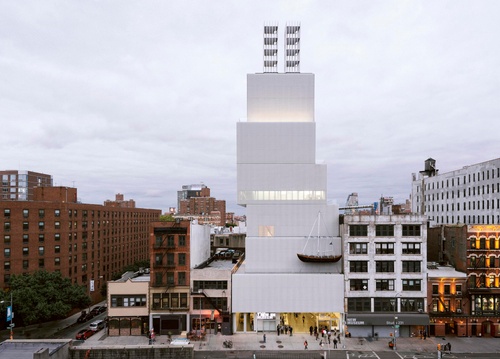
In 2007, the New Museum opened its first custom-built home at 235 Bowery. Its vertical design and mesh façade has allowed artists to innovatively install works on even the exterior surfaces. Above: Chris Burden’s Ghost Ship (2005) and Twin Quasi-Legal Skyscrapers (2013) installed as part of “Chris Burden: Extreme Measures,” 2013. Photo: Dean Kaufman
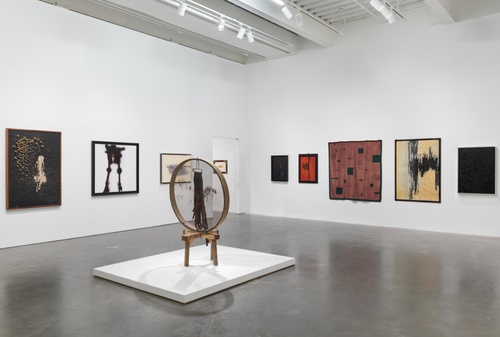
Installation view of “Carol Rama: Antibodies,” New Museum, New York, 2017. Photo: Maris Hutchinson / EPW Studio
LC: Is there anything else that you want to say about the New Museum while we’re recording, for the public record? We’ve covered a lot.
LS: For the public—we are the role model for any contemporary museum anywhere, period.
LC: I agree.
LS: And hope we continue to be.
LC: My last remark will be that Laura Skoler is a role model for a trustee anywhere.
LS: Oh, thank you.
[End of interview.]
-
Skoler joined the New Museum Board of Trustees in 1983. New Museum of Contemporary Art, The New Museum of Contemporary Art: Fall 1983/ Winter 1984 Newsletter, 1983, 1
-
Skoler helped plan Celebration II, the Museum’s second annual benefit party, as Activities Council Chair in 1980. New Museum, The New Museum Report 1979–1981,(New York, New Museum, 1981), 11.
-
Art Quest “was initiated in the spring of 1981 by Marcia Tucker, with Jock Truman and the Museum’s Activities Council,” of which Skoler was the chair. The program was designed to “facilitate interaction among collectors,” by organizing “frequent tours of unaffiliated artists’ studios, lectures by visiting artists, museum directors and curators, and critics; tours of New York City’s unusual, out-of-the-way alternative spaces; and an annual listing of artists, galleries and arts organizations in major cities across the United States.” New Museum, The New Museum Report 1979–1981,(New York, New Museum, 1981), 15.

